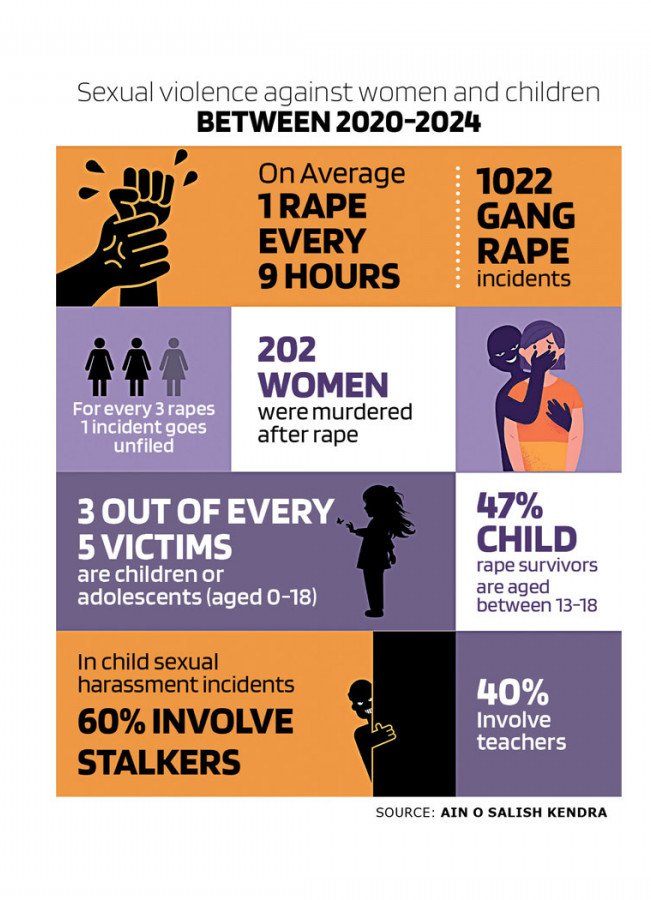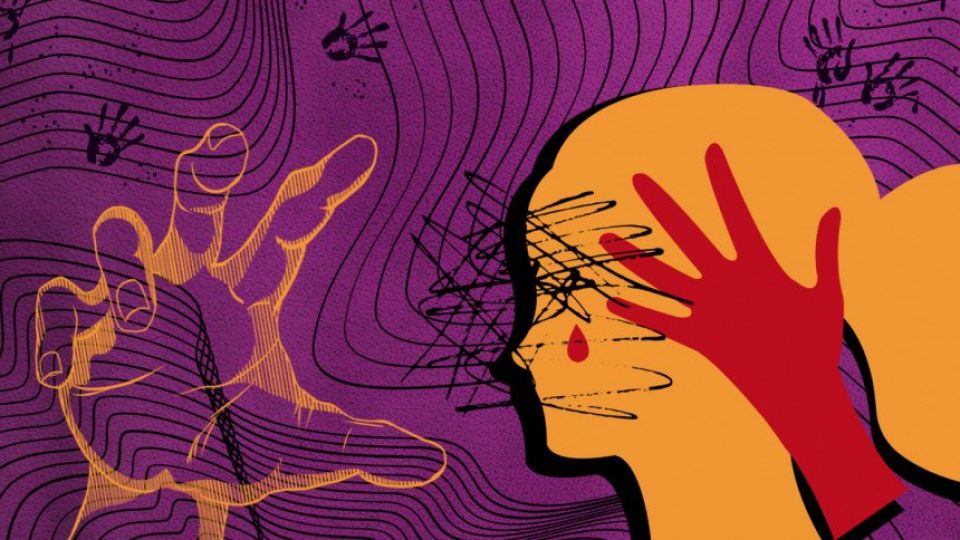November 25, 2024
DHAKA – Marium (not her real name) was only 10 years old when she was subjected to the horrors of sexual violence in 2018.
A middle-aged man raped her in the slum she lives in.
The child narrated the incident to her grandmother and a group of women, including a community activist.

GRAPHICS: THE DAILY STAR
Her grandmother, however, decided to hush up the matter to protect Marium’s “reputation.”
Despite the community activist’s attempt to seek legal justice for the child, her ‘honour’ mattered more to the grandmother and their community.
When police arrived, the community members dismissed the incident as an “overblown rumour” — ultimately granting the rapist impunity and offering him the chance to further exploit the child and other girls of the slum.
This is an edited excerpt of a case study from the research report titled “Why Rape Survivors Stay Out of Court: Lessons from Paralegal Interventions” published by BLAST in 2018.
The scenario in Bangladesh has changed little since then. Under-reporting of rape cases remains a problem, according to experts.
For instance, data from the prominent human rights organisation Ain o Salish Kendra (ASK) showed a total of 4,787 rape cases from January 2020 to September 2024.
In 2020, 1,627 rape cases were reported, while only 329 were reported between January and September 2024.
Legal experts say the rape data underrepresents the true scope of the problem as many rapes go unreported.
An analysis by this correspondent of the ASK data over four years showed that there was one rape every 9 hours — meaning at least two women have been raped in Bangladesh each day during this period just based on reports published in the media.
A 2024 report by the National Girl Child Advocacy Forum noted that, amid political unrest and crises in Bangladesh, the needs of women, girls and vulnerable groups were overshadowed in media coverage.
Supreme Court lawyer and ASK Chairman ZI Khan Panna also shared this concern, noting, “I believe the actual number is much higher. We rely on newspaper data, and when necessary, verify cases with the police. Naturally, the numbers are lower if victims don’t come to police.”
Barrister Jyotirmoy Barua said, “We estimate that about 30 out of every 100 incidents are never reported.”
Experts pointed out there has been no fundamental societal shift to reduce rape incidents; instead, insecurity, distrust in the justice system, and doubts about legal processes continue to grant impunity to rapists.
“Social power dynamics remain the same, regardless of which party is in power, so reporting may dip, but actual incidents likely have not,” said Jyotirmoy.
AT LEAST 1 IN 3 RAPES REMAIN UNFILED
Of the 4,787 rapes reported by media, only 3,419 resulted in filed cases, leaving nearly one in three incidents unfiled.
Women’s Rights Activist Khushi Kabir attributed this to the lack of support in the legal system. “Women face distressing conditions in court, and cases can drag on for 8-10 years. This makes it nearly impossible for complainants to endure the costs, social pressures, and lengthy battle.”
Barrister Jyotirmoy asked, “There’s no guarantee that a victim will get justice even if they file a case, so why would they bother?”
He added, “Rape cases often remain unresolved beyond the mandated 180-day timeframe, and convictions are rare.
“The court alone cannot deliver justice, as 99 percent of the process — filing the case, conducting investigations, and presenting witnesses — is carried out by state authorities. The public’s lack of trust in the entire system which is severely flawed, discourages victims from filing and reporting cases, ultimately undermining the court’s ability to deliver justice.”
Legal researcher Taqbir Huda, author of the 2018 BLAST study, says the absence of a state compensation mechanism for victims is responsible too. “Without such a system, rapists can essentially buy impunity by offering survivors or their families small sums, preventing them from filing a case in the first place or coaxing them into abandoning the prosecution later.”
Despite the Law Commission submitting the draft Crime Victims Compensation Act to the home ministry in 2007, it remains unaddressed till date, leaving survivors of rape and violence feeling alienated from the state mechanism.
DEATH PENALTY IN 2020
Experts also cite the death penalty, introduced in 2020, as a possible reason behind low convictions.
Taqbir said judges currently can only choose between life imprisonment and the death penalty, which leads to convictions only in the most severe cases.
Jyotirmoy Barua said, “The death sentence achieves little; rather, it often increases the chance that cases never reach a verdict. Every criminal case requires guilt to be proven beyond a reasonable doubt, with no deviation. The death penalty has frequently stalled the legal process, delaying justice even further.”
3 OF EVERY 5 VICTIMS ARE CHILDREN
The five-year data analysis also revealed that 2,862 children aged 18 and under were raped during this period, accounting for three out of every five victims.
Of the cases which identified the victims’ ages, 47 percent were aged 13 to 18.
According to ZI Khan Panna, children are often targeted for sexual abuse because they are minors, less conscious, and unaware of their surroundings.
“Their vulnerability combined with their inability to protest or fully comprehend the situation makes them easy targets for perpetrators who exploit this psychological advantage.”
On October 12 this year, a nine-year-old girl was raped by an unknown man after he lured her with the promise of Tk 200 if she would carry a bag to his house.
The sexual assault left the girl in need of surgery to create a path for eliminating waste, her mother told reporters. “Doctors are working to restore normal [bodily] functions, but my daughter’s health risks remain uncertain.”
Panna said, “If every school introduced mandatory martial arts training and included comprehensive sex education in the curriculum, incidents of rape, sexual harassment, and domestic violence could decrease significantly.”
Roksana Sultana, executive director of Breaking the Silence – a child rights organisation, highlighted how the culture of silence enables sexual abuse within families.
“From a young age, children are often pressured to stay silent about abuse, especially within families. The fear of blame or disbelief forces them to endure repeated harm in silence.”
Roksana stressed teaching children about body boundaries and empowering them to say “No”.
“Weak state mechanisms fuel all forms of abuse,” she said, urging major state reforms.
“As long as there are no interventions to protect women and girls, we cannot decrease the crime against them,” stressed ZI Khan Panna.


